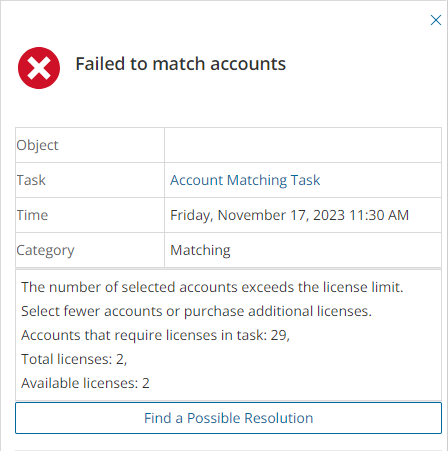Information about the migration project is summarized on the project dashboard. The tiles that you can see and the features that you can access through the project dashboard depend on your subscription. For information about subscriptions, see On Demand Global Settings Current User Guide.

Each tile on this dashboard presents a summary of the migration activities and lets you navigate to the respective migration service dashboards or list views as described below:
Welcome
Quick start your migration activities from this tile. The following activities can be performed here:

Grant Consent - If you see a green icon, you have granted the necessary consents to the source and target tenants associated with this project. Otherwise the Grant link is displayed and you can click the link to complete the authorization process for the source or target tenants.
Discover Accounts - If you see a green icon, you have already discovered one or more accounts in the source tenant. Otherwise, click Discover to open the Accounts List view and start a discovery process.
Match Accounts - If you see a green icon, you have matched one or more accounts between the source and target tenants. Otherwise, click Select to open the Accounts List view and start a matching process. You must discover one or more accounts before you can start the matching process.
Migrate Accounts - If you see a green icon, you have migrated one or more accounts from the source to the target tenant. Otherwise, click Select to open the Accounts List view and start a migration process. You must match one or more accounts before you can start the migration process.
Accounts, Mail, OneDrive and Teams
These tiles presents information about the objects that were discovered or migrated in addition to other pertinent information. These objects are managed through the Account and User Data migration workspace and share a common dashboard. Click Open from the Accounts, Mail, OneDrive, and Teams tiles to access the common dashboard.
Public Folders
Displays information about the discovered and migrated public folders. Click Open to access the dashboard in the Public folder migration workspace.
SharePoint
This tile presents information about the discovered and migrated SharePoint objects. Click Open to access the dashboard in the SharePoint migration workspace.
Active Directory
Click Open to access the Active Directory migration workspace for Microsoft 365 domain move service, directory synchronization services for Microsoft Active Directory and Azure Active Directory, and other migration services for Microsoft Active Directory.
Tasks
Displays the five most recent tasks that were completed in the Accounts and User Data migration workspace. Click Show All to open the Tasks List view in the Accounts and User Data migration workspace.
Events
Displays the five most recent events that were completed in the Accounts and User Data migration workspace. Click Show All to open the Events List view in the Accounts and User Data migration workspace.
On Demand Migration offers two types of reports:
Activating Premigration and Comparison reports
Premigration reports are protected by Role-based Access Control (RBAC). To activate the premigration reports dashboard, follow the steps below:
- From the On Demand navigation pane, go to Settings > Access Control > Roles.
- Edit a custom role or create a new role. You cannot edit a predefined On Demand role.
- Scroll down to the Migration section and select the View reporting dashboard check box. Granting this permission exposes a Reports tab in the project workspace

- By default, all asset types are included with the permission. You can remove one or more asset types to restrict access those reports.
- Click Create Role to save the settings for a new role or click Save to save the settings for an existing role. Users who are assigned this role can see the Reports tab in the project workspace and access the reports for the permitted asset types.
Premigration Reports
Premigration reports provide detailed information about discovery tasks which get information about the various assets in the source tenant which you plan to migrate to the target tenant. These reports can be downloaded as Microsoft Excel files for offline inspection and migration planning.
Premigration reports are generated every time you run a discovery task for an Office 365 asset. The following is a list of discovery task commands that support report generation:
|
Accounts
Mailbox
OneDrive
|
SharePoint
Teams
M365 Groups
|
These reports are accessible from two places:
- Task details pane
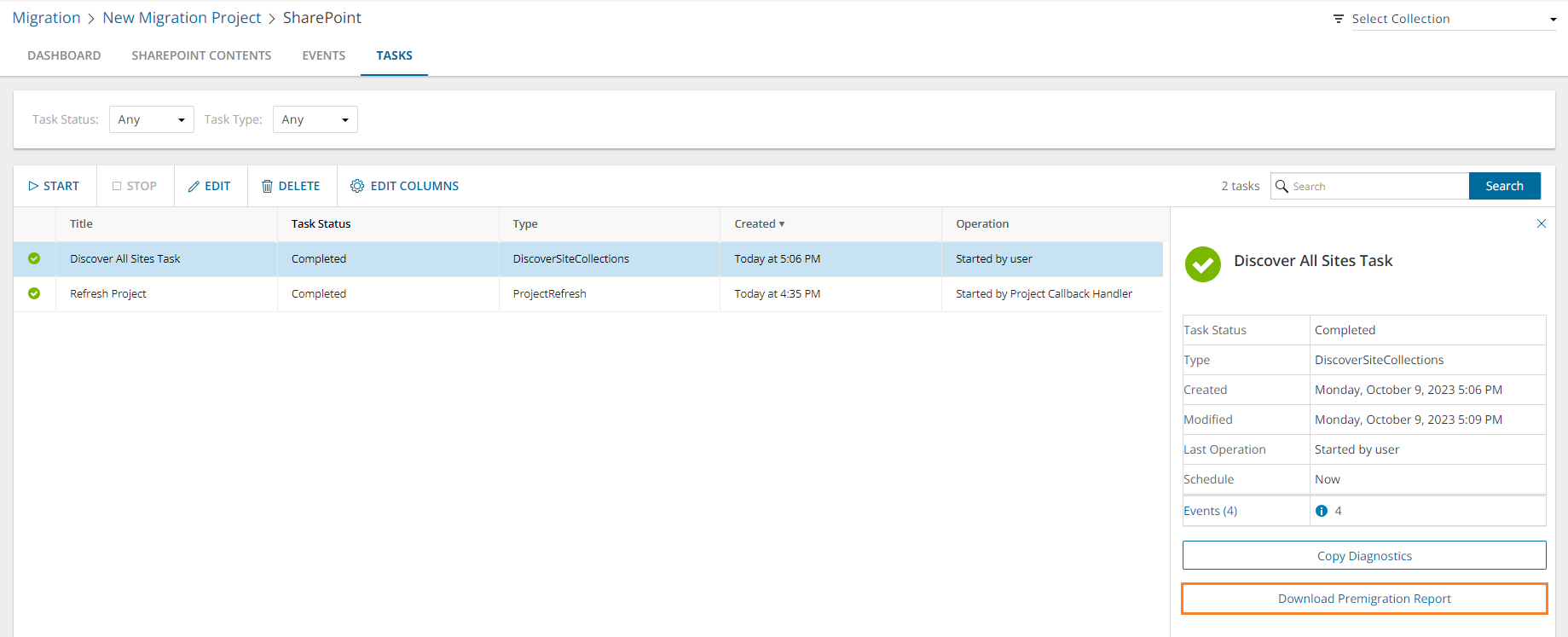
To download a premigration report from the task details pane:
- Select any discovery task that is completed.
- From the task details pane, click Download premigration report.
- Reports tab in the project workspace
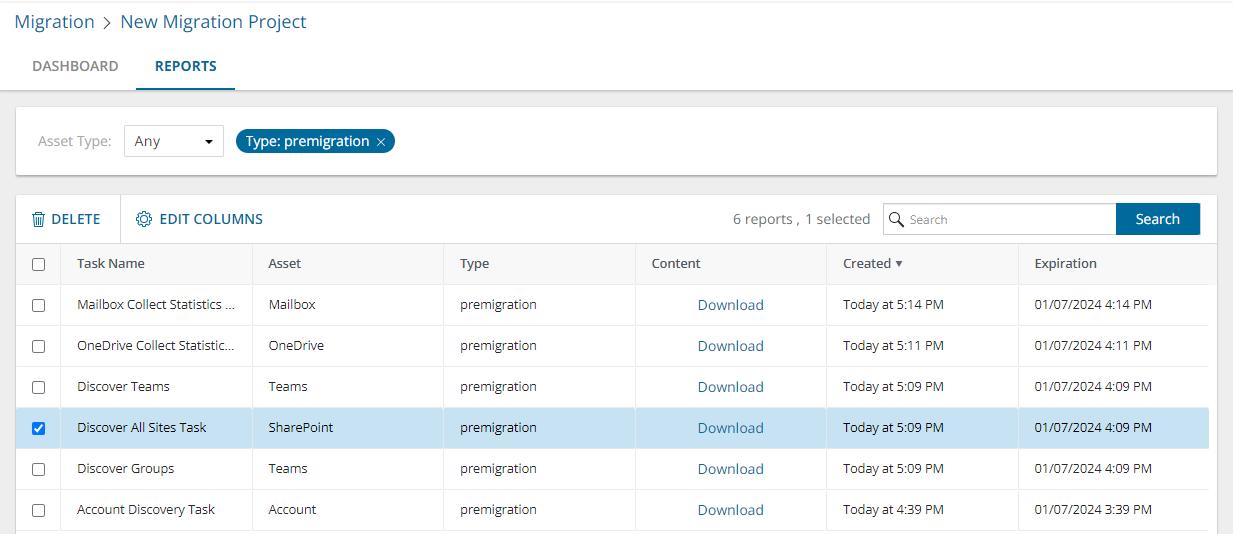
The Reports list view has the following columns:
- Task Name - name of the discovery task. The names indicated here are default names and may be different from task names that you have specified.
- Asset - name of the Microsoft 365 asset that is discovered in the source tenant.
- Type - type of report. This value should be premigration.
- Content - link to the Microsoft Excel file that will be downloaded when you click the link.
- Created - date and time when the report is created.
- Expiration - date and time when the report will expire and the download link will be deactivated. Reports are retained for 90 days.
To download a premigration report from the project workspace:
- Filter the list using the predefined filters: Asset Type and Report Type.
- Set Report Type = premigration
- Set Asset Type = Asset you want to get the report, or select 'Any'. The Asset Type filter dropdown also indicates the number of reports in the list for each asset type.
- From the Content column click Download.
Analyzing premigration reports
Reports are downloaded as a compressed ZIP file. You must extract the Microsoft Excel report.
Each report has a Summary worksheet. Helpful information about the objects discovered by the discovery task are presented in this worksheet.
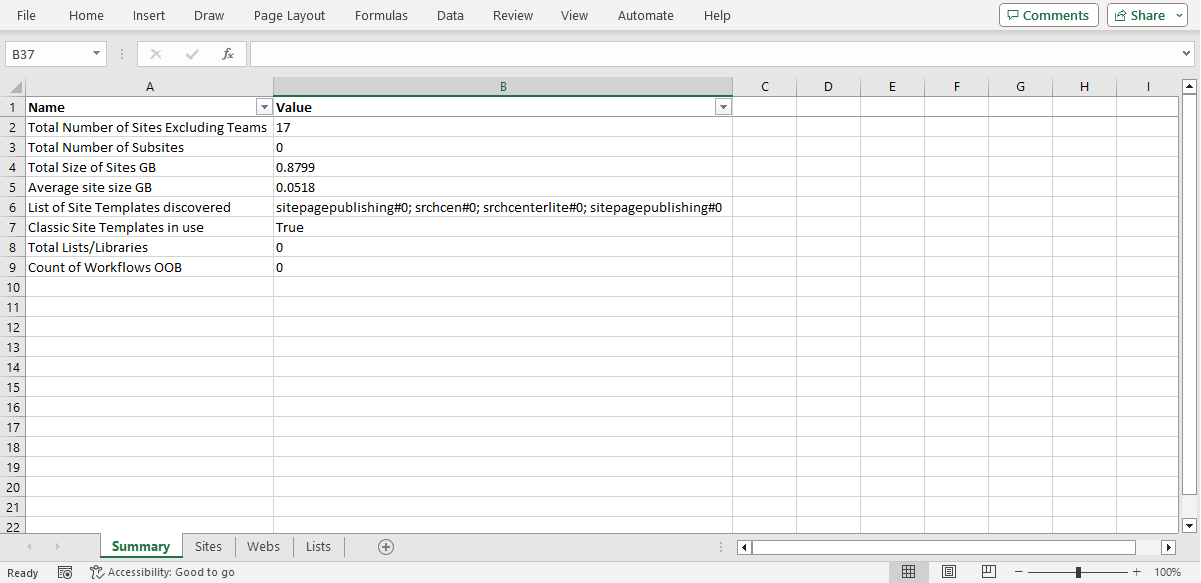
If the asset type has related objects associated with each item, then more worksheets are added. For example, a SharePoint site discovery report will have additional worksheets like Webs and Lists. You may have to run additional discovery tasks to access information about related objects.

Comparison Reports
Comparison reports provide detailed information about various assets in the source and target tenants. These reports can be downloaded as Microsoft Excel files for offline inspection, migration planning and verification.
Comparison reports are generated every time you run a Collect Statistics task on a target tenant for an Office 365 asset. The following is a list of task commands that support comparison report generation. Generating comparison reports requires the selection of a specific option in the task wizard. See the topic about the collect statistics task wizard from the links provided in the list below.
|
Accounts
Mailbox
OneDrive
|
SharePoint
Teams
M365 Groups
|
These reports are accessible from two places:
- Task Details pane
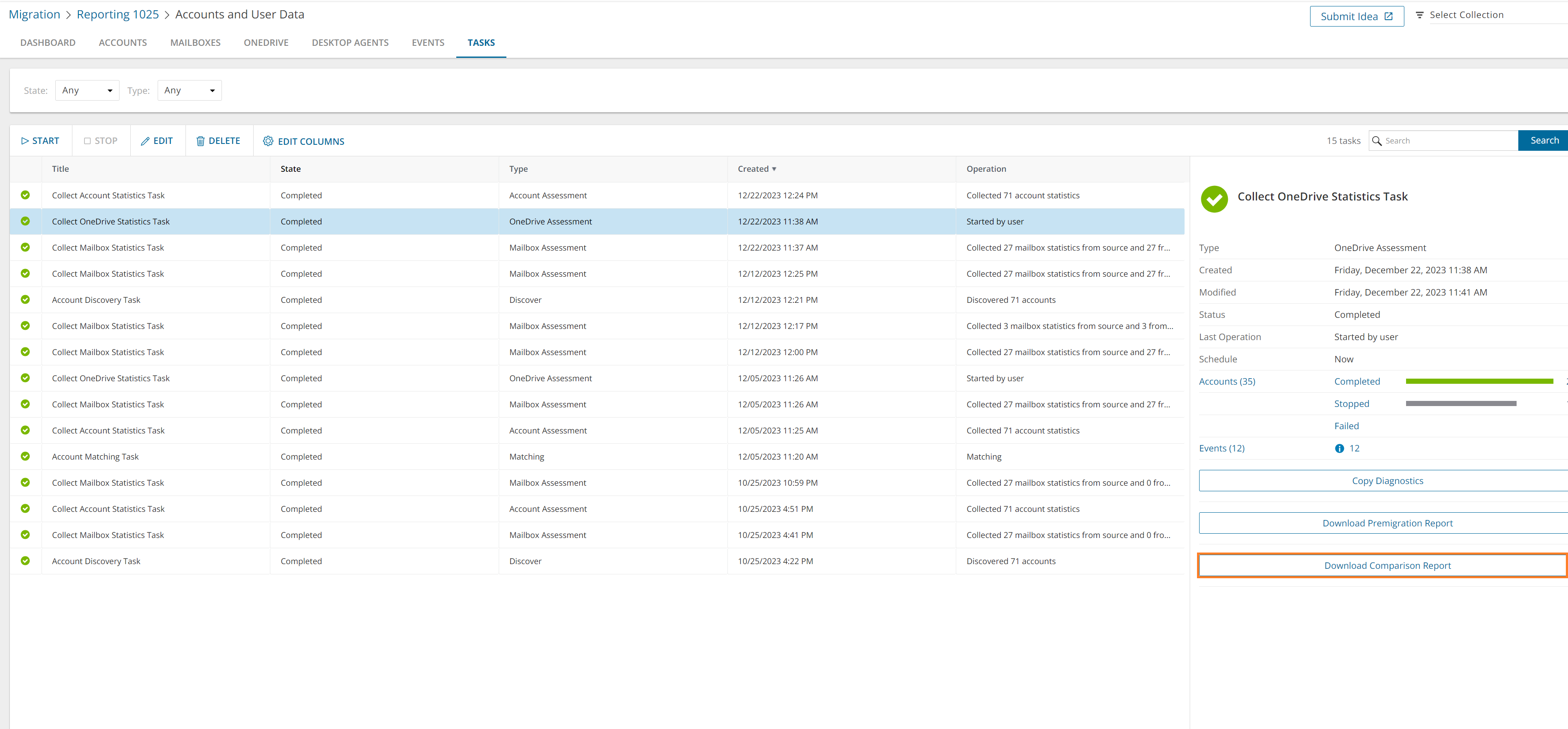
To download a comparison report from the task details pane:
- Select any discovery task that is completed.
- From the task details pane, click Download comparison report.
- Reports tab in the project workspace
The Reports list view has the following columns:
- Task Name - name of the discovery task. The names indicated here are default names and may be different from task names that you have specified.
- Asset - name of the Microsoft 365 asset that is discovered in the source tenant.
- Type - type of report. Valid value are comparison and premigration. Select comparison in the filter for premigration reports.
- Content - link to the Microsoft Excel file that will be downloaded when you click the link.
- Created - date and time when the report is created.
- Expiration - date and time when the report will expire and the download link will be deactivated. Reports are retained for 90 days.
To download a comparison report from the project workspace:
- Filter the list using the predefined filters: Asset Type and Report Type.
- Set Report Type = comparison.
- Set Asset Type = Asset for which you want to get the report, or select 'Any'. The Asset Type filter dropdown also indicates the number of reports in the list for each asset type.
- From the Content column click Download.
Analyzing comparison reports
Reports are downloaded as a compressed ZIP file. You must extract the Microsoft Excel report. If the asset type has related objects associated with each item, then more worksheets are added. For example, a SharePoint site discovery report will have additional worksheets like Webs and Lists.
Notice that there are column pairs: one for the source and another for the target tenant. Discrepancies in the statistics between source and target are highlighted in red.

Migration Reports
Migration Reports display error reports about migration tasks. Additionally, each migration workspace has its own Reports tab.
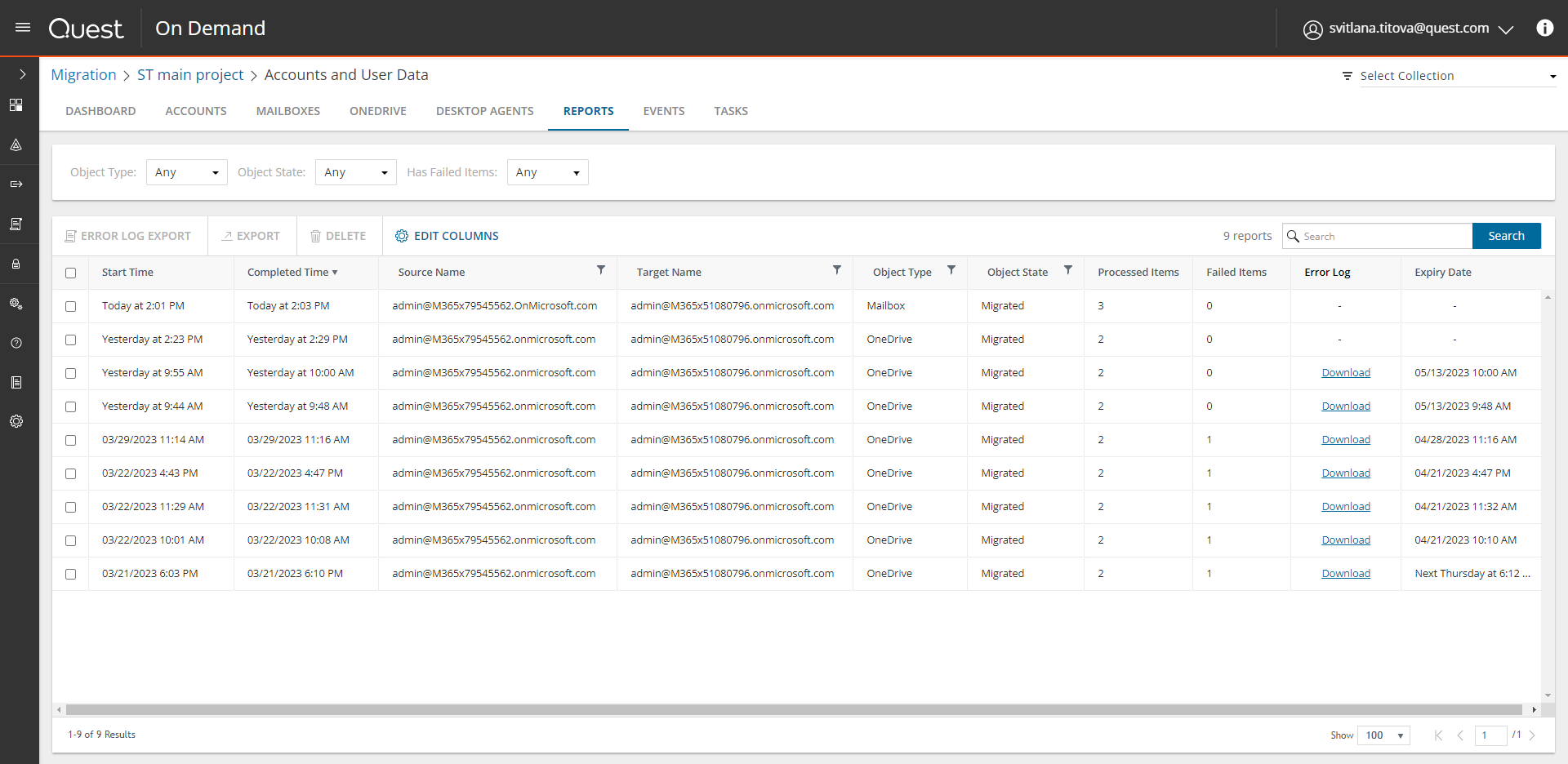
About Migration Reports
- The error report for a migration job is a CSV file with one or more rows. The maximum number of rows in the CSV file is 50K. You can download a report by clicking the Download link in the Error Log column. If there are no migration errors, a download link is not available.
- Error reports are retained for 30 days. You cannot modify this global setting. After 30 days the download link is replaced with the label Expired and you can no longer download the report.
- You can select one or more reports and delete them with the Delete action. If the reports are active when they are deleted, the row in the table will be removed and the report will be automatically purged after 30 days.
- Access to reports are secured with Role Based Access Control (RBAC). For example, if you have access to only Mail migration, the OneDrive reports are not visible.
- If a migration project is deleted, all associated data will be deleted, and any active reports will be purged after 30 days.
The columns in the reports list are as described bellow:
- Start Time - the date and time the migration task was started.
- Completed Time - the date and time the migration task completed.
- Source Name - name of the source tenant.
- Target Name - name of the target tenant.
- Object Type - name of the asset that is migrated.
- Object State - the state of the migration. Values are: Migrated, Partially Migrated, Migrated with Issues, Migration Failed and Migration Stopped.
- Processed Items - the number of asset items from the source tenant that were included in the migrattion.
- Failed Items - the number of asset items that could not be migrated successfully.
- Error Log - link to the report if available. If there are no migration errors, a download link is not available. After 30 days the download link is replaced with the label Expired.
- Expiry Date - date and time when the report will expire.
Exporting Reports
- You can download a single report by clicking the Download link in the Error Log column. If there are no migration errors, a download link is not available.
- You can select multiple rows and download the reports as a ZIP file when you click Error Log Export.
- You can select multiple rows and download the reports list when you click Export. Only rows are exported but not the report CSVs.
Filtering the Reports List
You can use the following predefined filters to retrieve a subset of the reports:
- Object Type - name of the asset that is migrated.
- Object State - the state of the migration. Values are: Any, Migrated, Partially Migrated, Migrated with Issues, Migration Failed and Migration Stopped.
- Has Failed Items: whether or not the migration has any failed items. Values are Yes or No. If there are one or more items that match a Yes or No value, the number of items are indicated as well.
In this topic:
Viewing the task list
Each On Demand Migration dashboard has a Tasks tab.
Click the Tasks tab to see the Tasks list. The Tasks list displays all the tasks that are initiated throughout the migration process. From the Tasks list you can:
- Track the progress of a task and view the results of finished tasks. When you select a task, the task details pane appears and displays the details the detailed information and statistics of the task.
- Filter and search to quickly navigate through the list of tasks.
- Start, stop, and delete tasks.
- Edit tasks
The columns in the Tasks list are as described below:
- Title - name of the task that is initiated. You can specify custom names for task when they are created from the various task wizards.
- State - state of the task as it transitions from initiation to completion.
- Type - type of the task. For example, the following are some of the task types that are used in On Demand Migration:
| Account |
Mailbox |
OneDrive |
SharePoint |
| Discovery |
Mailbox Assessment |
OneDrive Assessment |
ProjectRefresh |
| Matching |
Mail Migration |
OneDrive Migration |
DiscoverSiteCollections |
| Migration |
Mailbox Switch |
|
DiscoverSharePointContents |
| Resource Processing |
Address Rewriting |
|
MatchSharePointContents |
| Map From File |
Meeting Link Migration |
|
MappingFromFileSharePointContents |
| Assign ODM License |
Calendar Sharing |
|
MigrateSharePointContents |
| Collect Account Statistics |
Collect Mailbox Statistics |
|
|
- Created - date and time the task is started.
- Operation - description of what the task accomplished.
|
NOTE: Depending on selected task options and content volume, batch processing is used increase the efficiency of the task. It can take a while before processing of the submitted batches is completed. To help track the task, the task status is updated every 5 minutes approximately. |
Viewing task details
The task details pane provides the following information:
- Name - name of the task used as the title of the details pane.
- Type - type of the task.
- Created - date and time the task is started.
- Modified - date and time the most recent operation in the task is performed.
- State - state of the task as it transitions from initiation to completion. Valid values are New, In Progress, Failed, Stopped, Completed and Completed with Issues. The state of an object is set to Stopped when a task is stopped by the user.
- Last Operation - most recent operation that the task accomplished.
- Schedule - how the task is started. The values are:
- Now - if the task is started immediately after the task wizard is completed.
- On Demand - if the task is started manually.
- <timestamp> - if the task is scheduled to start at a scheduled date and time.
- Events - number of events that occurred during the task.
Click Copy Diagnostics to copy relevant task properties to the clipboard. You can then paste the properties in a text file and provide the information to Technical Support for troubleshooting or use the properties in PowerShell commands. The information that is copied to the clipboard is described below:
- Organization ID - unique identifier of the Quest On Demand organization.
- Deployment Region - Azure region code. Each Azure geography contains one or more regions that are used for specific data residency and compliance requirements.
- Organization Name - name of the Quest On Demand organization.
- Project ID - unique identifier of the migration project.
- Task ID - unique identifier of the task.
Scheduling tasks
To optimize performance you can select scheduling options for all tasks in the Schedule step of task wizards. This is reasonable for the task that may take a considerable amount of time. The following options are available:
- Run now - task runs immediately.
- Run later - task must be started manually.
- Schedule - task will be started at a future date and time entered in the corresponding calendar field.
Editing tasks
From the Tasks list you can edit previously created tasks to reuse them in one of three ways:
Editing a completed task
You can edit a completed task. Depending on the schedule option selected you can:
- Automatically restart changed task in case Run now option is selected.
- Manually start changed task in case Run later option is selected. All changes will be applied after the task is restarted.
- Schedule the start for the changed task in case Schedule option is selected. All changes will be applied after the task is restarted.
|

|
NOTE: You cannot undo this operation after the wizard is finished to reset the edited task to initial settings. |
Editing a running task
You can edit a running task to reuse or restart it. Depending on the schedule option selected you can:
- Automatically restart changed task in case Run now option is selected.
- Manually start changed task in case Run later option is selected. All changes will be applied after the task is restarted.
- Schedule start for changed task in case Schedule option is selected. All changes will be applied after the task is restarted.
|

|
NOTE:
- Your changes cannot affect the task that is currently running.
- You cannot undo this operation after the wizard is finished to reset the edited task to initial settings.
|
Editing a task that has not started
You can edit task in case it is not started to change your settings. Depending on the schedule option selected you can:
- Automatically start changed task in case Run now option is selected.
- Manually start changed task in case Run later option is selected.
- Schedule start for changed task in case Schedule option is selected.
|

|
NOTE: You cannot undo this operation after the wizard is finished to reset the edited task to initial settings. |
Stopping and restarting tasks

To stop a running task:
- Open the On Demand Migration Tasks tab.
- From the tasks list, click the running task. The Stop button is activated.
- Click Stop.
- A confirmation dialog appears. Click Stop
|

|
NOTE: The task may take a few minutes to change state. |
To restart a stopped task:
- Open the On Demand Migration Tasks tab
- Select a task where the State is "Stopped". The Start button is now enabled.
- Click Start.
- A confirmation dialog appears. Click Start.
|

|
NOTE: The task will restart from the beginning using the same settings. |
Each On Demand Migration dashboard has a Events tab.
Click the Events tab to see the Events list. The Events list displays all the events related to tasks that are initiated throughout the migration process. It lets you:
- View all events related to a task. Use search or filtering to quickly retrieve events of interest.
- View details related to the event on the right hand pane when you select an event.
- Hide certain alerts from the list by using the Acknowledge option. This might be useful if you don’t want to be distracted by the accidental warning or “expected” error.
- Export selected events into comma-separated values (CSV) file for analytic or archival purposes.
- Look for resolutions to error events. In the event detail pane, click Find a Possible Resolution to look for a solution from among the applicable Knowledge Base (KB) articles in the Quest website. If there is no solution found, the KB article search page is displayed.
